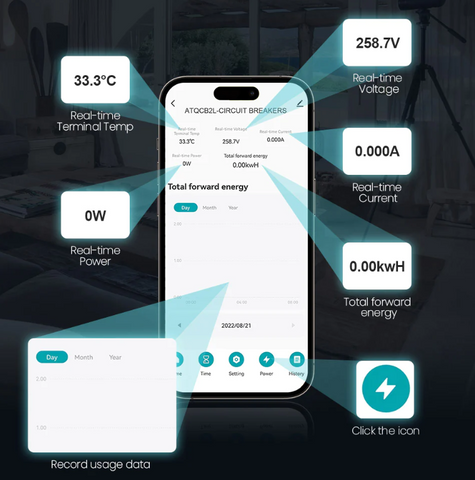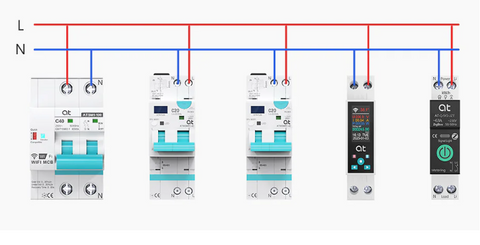How Does WiFi Circuit Breakers Help with Energy Management?
Energy management is a comprehensive approach to monitoring, controlling, and conserving energy resources within various sectors, including residential, commercial, and industrial settings. It encompasses strategies and practices aimed at optimizing energy consumption while ensuring sustainability and minimizing environmental impacts.
The way we manage and control energy has evolved significantly over the years. One of the most revolutionary advancements in this domain is the development of WiFi circuit breakers. These devices have transformed traditional electrical distribution systems into intelligent, energy-efficient networks. In this blog, we will explore the role of WiFi breakers in modern energy management and their potential to revolutionize the way we use electricity.

Understanding Energy Management
A. The Concept of Energy Efficiency
Energy efficiency is at the core of effective energy management. It involves using energy in a way that minimizes waste and maximizes output. It's not just about using less energy; it's about getting more value from the energy consumed. Energy efficiency measures can range from upgrading appliances to industrial process optimization.
B. Benefits of Effective Energy Management
Effective energy management offers numerous benefits, including reduced energy bills, improved environmental sustainability, and enhanced competitiveness for businesses. It can also enhance the comfort and productivity of individuals in residential settings. Moreover, it contributes to reducing the strain on the power grid and promoting energy independence.
C. Challenges in Traditional Energy Management
Traditional energy management has often relied on manual data collection and monitoring. This approach can be labor-intensive and lacks the precision required for efficient energy use. Additionally, it may not adapt to the dynamic nature of energy consumption patterns, making it less effective in the face of changing demands and energy sources.
WiFi Circuit Breakers: An Overview
A. Definition and Purpose of Circuit Breakers
Circuit breakers are essential components in electrical systems. They are designed to protect electrical circuits from overcurrent and prevent electrical fires. When an overload or fault occurs, circuit breakers interrupt the electrical flow, improving the safety of the connected devices and the surrounding environment.
B. Introduction to WiFi Circuit Breakers
WiFi smart circuit breakers build upon the fundamental functionality of traditional breakers by incorporating advanced technology. These devices offer real time monitoring, remote control, and data analytics capabilities, making them integral to modern energy management systems.
C. Key Features and Capabilities
WiFi circuit breakers are equipped with features like remote operation, load monitoring, and data analytics. They can communicate with other devices and systems, offering a comprehensive view of energy consumption. Their advanced sensors and connectivity enable intelligent decision-making for energy optimization.
The Role of WiFi Circuit Breakers in Energy Management

A. Real-Time Monitoring and Control
WiFi circuit breakers provide real-time insights into energy usage, allowing users to remotely control and monitor electrical circuits. This real-time data helps in identifying and addressing inefficiencies promptly.
B. Load Balancing and Optimization
These devices can balance electrical loads, ensuring that energy is distributed efficiently across different circuits. Load optimization helps prevent overloading and reduces the risk of electrical faults.
C. Predictive Maintenance
WiFi circuit breakers can predict when they are likely to fail or require maintenance, thereby reducing unexpected downtime and enhancing system reliability.
D. Integration with Smart Grids
WiFi circuit breakers are compatible with smart grids, enabling seamless two-way communication between energy providers and consumers. This integration supports demand response programs and grid stability.
Advantages of WiFi Circuit Breakers

A. Enhanced Safety
WiFi circuit breakers enhance safety by quickly detecting and isolating faults, reducing the risk of electrical fires and accidents.
B. Energy Cost Savings
Through load optimization and efficient energy management, WiFi circuit breakers can lead to significant cost savings by reducing energy waste.
C. Reduced Downtime and Maintenance Costs
The ability to predict maintenance needs and address issues proactively minimizes downtime and maintenance expenses, making WiFi circuit breakers a cost-effective solution.
Certainly, here are examples of businesses that have adopted WiFi circuit breakers:

1. Manufacturing Facilities
Industrial manufacturers are increasingly incorporating WiFi breakers into their operations. These breakers can monitor the electrical load in real time and automatically shut down circuits in case of overload, preventing costly downtime and ensuring safety.
2. Data Centers
Data centers are highly reliant on stable power distribution. WiFi breakers help maintain a constant power supply, reducing the risk of data loss due to power disruptions. They also enable more efficient use of electricity, reducing operating costs.
3. Retail Chains
Large retail chains with multiple locations use WiFi circuit breakers to remotely monitor and control electrical systems. This allows them to optimize and manage energy consumption, reducing their carbon footprint and energy bills.
4. Hospitals
Hospitals require a reliable power supply to operate critical medical equipment. WiFi circuit breakers enhance power quality, helping healthcare facilities maintain a consistent supply of electricity, which is essential for patient care.
5. Agricultural Operations
Modern farms and agricultural operations use WiFi breakers to automate irrigation systems, control lighting, and monitor equipment. This automation increases efficiency, reduces energy waste, and enhances crop yields.
6. Commercial Buildings
Office buildings and commercial spaces use WiFi circuit breakers to manage power distribution efficiently. They can be programmed to optimize lighting, heating, and cooling systems, resulting in energy savings and reduced operating costs.
7. Renewable Energy Installations
WiFi circuit breakers play a crucial role in renewable energy installations such as solar and wind farms. They can manage the integration of intermittent energy sources into the grid, ensuring a smooth flow of electricity while preventing overloads.
8. Hotels and Hospitality
WiFi breakers enable hotels to control and monitor power usage in guest rooms and common areas. They can adjust energy consumption based on occupancy, leading to energy savings without sacrificing guest comfort.
9. Educational Institutions
Schools and universities are adopting WiFi circuit breakers to manage their electrical systems more efficiently. These systems help reduce energy consumption and maintenance costs, allowing institutions to allocate resources to educational programs.
10. Mining Operations
Mining companies use WiFi circuit breakers to manage power distribution in remote and challenging environments. These systems help prevent electrical failures and protect equipment, which is critical for mining operations.
Conclusion
In conclusion, effective energy management is vital for sustainability, cost savings, and environmental preservation. It's a responsibility shared by individuals, businesses, and governments worldwide.
WiFi circuit breakers are not just devices; they represent a leap forward in energy management. Their ability to monitor, control, and optimize energy usage is central to the energy management systems of the future.
AT-ELE looks to the future, the development of energy-efficient technologies, like WiFi breakers, will continue to drive our quest for a more sustainable, efficient, and eco-friendly world. Embracing these innovations will be key to our energy future.
Contact:
AT-ELE
sale@at-ele.com
www.at-ele.com




